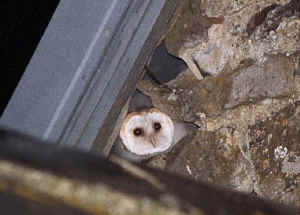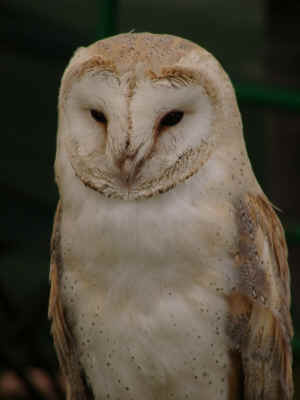| Barn Owls, although still
widespread in Devon, have declined in numbers over recent years. Because they are much
less common than they once were, an individual Species Action Plan has been created to
promote them within the overall Devon Biodiversity Action Plan (BAP). (More
on Devon BAP here)
| Barn Owls are essentially a bird of farmland. They do not
occur within the Woodland Education Centre at Offwell, because the habitat is not suitable
for them. However, their ghostly shapes may be seen hunting in the half light of dawn and
dusk over nearby fields and grass road verges. The decline in their numbers is linked to
loss of suitable habitat as farming methods have changed, together with loss of nesting
sites. By day,
Barn Owls hide in holes and old buildings. They are mainly nocturnal, hunting especially
at dawn and dusk . As night begins to fall, they emerge to hunt in the half light. With
their soft white plumage, they glide soundlessly over rough grassy meadows, hunting for
voles and other small mammals.
Their plumage is dense and soft. The
wing feathers have fringes of hair-like projections at the tips which deaden sound and
allow the owl to fly as silently as a ghost. They often hunt in flight, gliding low over
the ground, with frequent changes of direction, descending to catch unsuspecting prey in
their powerful talons. They will also hunt from a convenient perch such as a fence post,
or wall, looking and listening before pouncing. |
 |
Barn Owls have amazing
hearing. (Their ears are hidden by the feathers.) Sound may actually be more
important than vision when they are hunting. Their prey can be caught in total darkness by
sound alone. However, the large eyes mean that they can also
see very well at low levels of light.
While they mostly eat mammals smaller than rabbits, such as voles
and mice, they may also catch and eat small birds, frogs, beetles, moths, bats and fish. |
 |
Barn Owls
often nest in buildings such as barns or in holes in old trees. They do not produce a nest as such, but just lay their eggs on ledges, beams
or on the floor of lofts in old buildings.
The young hatch at slightly different intervals. This is insurance
against losing the whole brood if food is temporarily short. |
Continue to
Dormouse |
